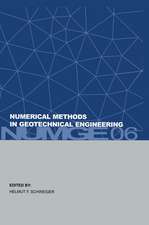The Competition between Polyphosphate-Accumulating Organisms and Glycogen-Accumulating Organisms: Temperature Effects and Modelling: UNESCO-IHE PhD Thesis
Autor Carlos Manuel Lopez Vazquezen Limba Engleză Paperback – 15 ian 2010
Preț: 474.37 lei
Preț vechi: 613.12 lei
-23% Nou
Puncte Express: 712
Preț estimativ în valută:
90.78€ • 94.43$ • 74.95£
90.78€ • 94.43$ • 74.95£
Carte tipărită la comandă
Livrare economică 14-28 aprilie
Preluare comenzi: 021 569.72.76
Specificații
ISBN-13: 9780415558969
ISBN-10: 0415558964
Pagini: 258
Ilustrații: 50 b/w images and 5 color images
Dimensiuni: 178 x 254 x 13 mm
Greutate: 0.48 kg
Ediția:1
Editura: CRC Press
Colecția CRC Press
Locul publicării:United States
ISBN-10: 0415558964
Pagini: 258
Ilustrații: 50 b/w images and 5 color images
Dimensiuni: 178 x 254 x 13 mm
Greutate: 0.48 kg
Ediția:1
Editura: CRC Press
Colecția CRC Press
Locul publicării:United States
Notă biografică
Carlos Manuel López Vázquez graduated in 1999 at the Faculty of Engineering, Autonomous University of the State of México (UAEMéx), in Toluca, México. He received the Masters degree on Water Sciences (cum laude), in 2002 at the Interamerican Center for Water Resources, Faculty of Engineering, at the same university. For outstanding academic achievement, he was awarded different prizes, grants and scholarships including the ‘Ingenieros Civiles Asociados (ICA) Scholarship’ in 1998 to the best students of Civil Engineering and the ‘Ignacio Manuel Altamirano Basilio Prize’ in 2001 given to the best MSc. student of the Faculty of Engineering.
In 2003, he was awarded a grant by the National Council for Sciences and Technology (CONACYT) from Mexico to carry out his doctoral studies, which started in 2004 in a joined project between UNESCO-IHE Institute for Water Education and the Environmental Biotechnology group of Delft University of Technology (TUDelft). The results of his PhD research are presented in this thesis.
In 2003, he was awarded a grant by the National Council for Sciences and Technology (CONACYT) from Mexico to carry out his doctoral studies, which started in 2004 in a joined project between UNESCO-IHE Institute for Water Education and the Environmental Biotechnology group of Delft University of Technology (TUDelft). The results of his PhD research are presented in this thesis.
Cuprins
Summary Chapter 1. Introduction Chapter 2. Temperature effects on the anaerobic metabolism of GAO Chapter 3. Temperature effects on the aerobic metabolism of GAO Chapter 4. Long-term temperature influence on the metabolism of GAO Chapter 5. Factors affecting the occurrence of PAO and GAO at full-scale EBPR systems Chapter 6. A practical method for the quantification of PAO and GAO populations in full-scale systems Chapter 7. Modelling the PAO-GAO competition: the effects of carbon source, pH and temperature Chapter 8. General conclusions, evaluation and outlook
Descriere
The book examines competition between glycogen-accumulating organisms and polyphosphate-accumulating organisms and their link to the instability of the enhanced biological phosphorus removal process in activated sludge wastewater treatment systems. Based on laboratory- and full-scale experimental work as well as mathematical modeling, this research contributes to better understanding about the environmental and operating conditions affecting the PAO-GAO competition and, therefore, the EBPR process performance and stability.
























